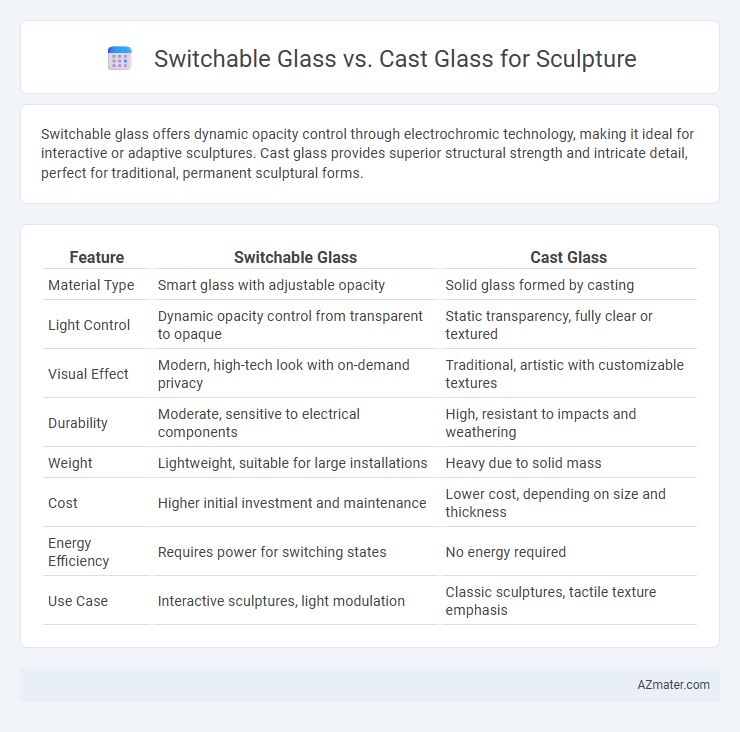Switchable glass offers dynamic opacity control through electrochromic technology, making it ideal for interactive or adaptive sculptures. Cast glass provides superior structural strength and intricate detail, perfect for traditional, permanent sculptural forms.
Table of Comparison
| Feature | Switchable Glass | Cast Glass |
|---|---|---|
| Material Type | Smart glass with adjustable opacity | Solid glass formed by casting |
| Light Control | Dynamic opacity control from transparent to opaque | Static transparency, fully clear or textured |
| Visual Effect | Modern, high-tech look with on-demand privacy | Traditional, artistic with customizable textures |
| Durability | Moderate, sensitive to electrical components | High, resistant to impacts and weathering |
| Weight | Lightweight, suitable for large installations | Heavy due to solid mass |
| Cost | Higher initial investment and maintenance | Lower cost, depending on size and thickness |
| Energy Efficiency | Requires power for switching states | No energy required |
| Use Case | Interactive sculptures, light modulation | Classic sculptures, tactile texture emphasis |
Introduction to Glass Sculpture
Switchable glass offers dynamic privacy and light control for sculpture displays, enhancing interaction by shifting transparency with electrical signals. Cast glass provides robust, three-dimensional depth and intricate details, ideal for permanent, solid structures in sculpture art. Both materials serve distinct artistic purposes, with switchable glass emphasizing versatility and cast glass focusing on tactile solidity and visual texture.
What is Switchable Glass?
Switchable glass, also known as smart glass, is a dynamic material that changes from opaque to transparent when an electrical current is applied, offering privacy and light control for sculptures. It incorporates a conductive film between glass layers, allowing instant transformation to showcase or conceal artwork without altering the sculpture's physical structure. Unlike cast glass, which is solid and static, switchable glass enhances interactive display possibilities by providing versatile visual effects and environmental control.
What is Cast Glass?
Cast glass is a technique where molten glass is poured into a mold to create solid, sculptural forms with intricate detailing and depth. It allows artists to achieve high levels of texture, translucency, and varying thickness, making it ideal for large-scale sculptures and three-dimensional artworks. Unlike switchable glass, which changes opacity electronically, cast glass offers permanent, tangible artistic expression through its physical mass and light interaction.
Visual and Aesthetic Differences
Switchable glass offers dynamic opacity control, allowing sculptures to shift from transparent to opaque, enhancing visual interaction by creating changing light and shadow effects. Cast glass provides a solid, textured surface with inherent variations in clarity and color, delivering a tactile aesthetic that emphasizes depth and form. The choice between the two significantly impacts the sculpture's visual narrative, with switchable glass emphasizing modern interactivity and cast glass highlighting artisanal craftsmanship.
Functional Properties: Transparency and Opacity
Switchable glass offers dynamic control over transparency and opacity through electric activation, enabling sculptures to transition between clear and frosted states instantly. Cast glass, however, provides fixed opacity and translucency based on its thickness and texture, creating consistent diffusion of light without adjustability. The functional advantage of switchable glass lies in its ability to modulate visibility and privacy, while cast glass emphasizes permanent aesthetic qualities and structural solidity.
Durability and Longevity Comparison
Switchable glass uses a liquid crystal film to toggle between opaque and transparent states, offering moderate durability but potential degradation over time due to electronic components. Cast glass, formed by melting and shaping molten glass, provides superior structural strength and longevity with resistance to environmental factors. Sculptures crafted from cast glass typically exhibit greater durability and maintain aesthetic integrity longer than those utilizing switchable glass technology.
Customization and Artistic Flexibility
Switchable glass offers dynamic opacity control, allowing artists to customize transparency levels and create interactive sculptures that change with light conditions. Cast glass provides substantial artistic flexibility through techniques like embedding, texturing, and shaping, enabling intricate three-dimensional forms and rich surface details. Combining switchable and cast glass can enhance sculptures with both visual depth and adaptable light modulation, expanding creative possibilities.
Installation and Maintenance Considerations
Switchable glass offers straightforward installation with standard glazing systems and requires proper electrical connections to enable its privacy function, while cast glass demands careful handling due to its weight and thickness, often needing custom framing and reinforced support structures. Maintenance for switchable glass involves routine electrical inspections and cleaning with non-abrasive materials to preserve its smart technology, whereas cast glass is low-maintenance but may require specialized cleaning to avoid surface damage and ensure long-term clarity. Both materials necessitate professional installation, but switchable glass provides dynamic functionality, whereas cast glass emphasizes durability and aesthetic depth.
Cost Analysis: Switchable vs Cast Glass
Switchable glass typically incurs higher upfront costs due to its technology-driven electrochromic or polymer-dispersed liquid crystal layers, with prices ranging from $100 to $150 per square foot, while cast glass costs vary widely from $75 to $200 per square foot depending on thickness and custom design complexity. Maintenance and energy savings from switchable glass can offset initial investment over time, making it cost-effective for projects requiring dynamic light control and privacy, whereas cast glass remains a popular choice for sculptures prioritizing aesthetic depth and durability without electronic components. Budget considerations should factor in installation complexity, expected lifespan, and artistic requirements, as cast glass demands specialized craftsmanship and switchable glass involves sophisticated electrical integration.
Choosing the Best Glass for Sculptural Artworks
Switchable glass offers dynamic opacity control, allowing sculptural artworks to transform their visual impact through privacy settings or light modulation, making it ideal for interactive or modern installations. Cast glass provides superior durability and rich texture, enabling artists to achieve intricate three-dimensional forms with depth and weight that enhance tactile and visual experience. Selecting between switchable and cast glass depends on the desired interplay of light, texture, and function in the artwork's environment and viewer engagement.

Infographic: Switchable glass vs Cast glass for Sculpture
 azmater.com
azmater.com